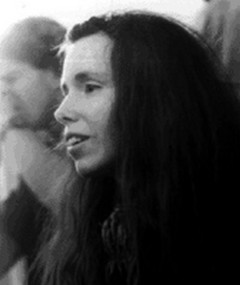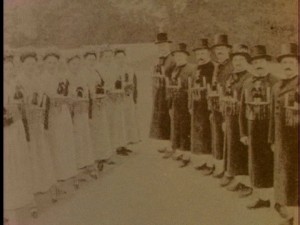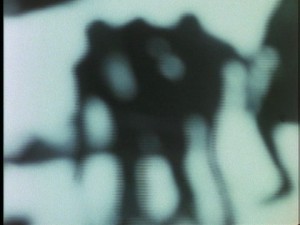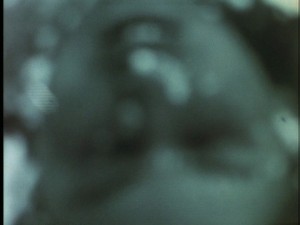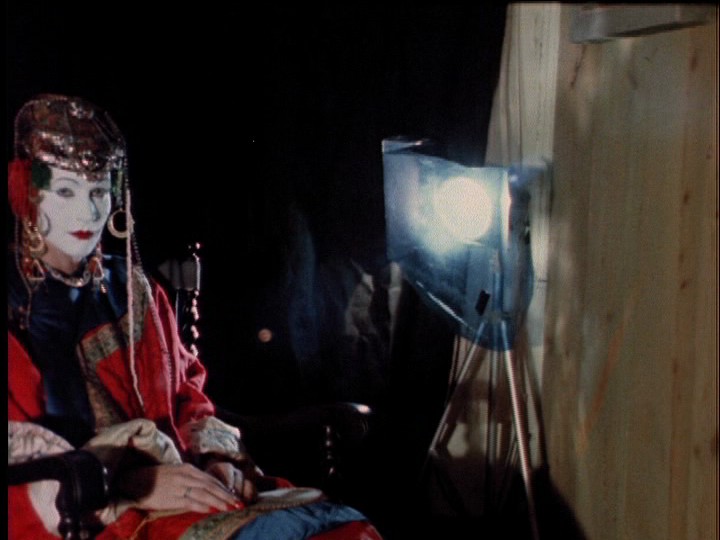A chapter from my book Film: The Front Line 1983. Apart from integrating a footnote into the main body of the text and eliminating a long out-of-date filmography, I’ve kept this text pretty much as I wrote it.
Adynata exists on both film and DVD, but, discounting unofficial/pirated/ underground sources, seems available, alas, only at institutional prices (from Women Make Movies and Electronic Arts Intermix — the latter of which also distributes X-Tracts and Jennifer, Where Are You?, both on video, along with Thornton’s subsequent works, 21 titles in all). One can, however, access her radically different and recent Novel City (2008), about seven minutes long, which draws on a few of Adynata‘s sounds and images and adds several others, here. — J.R.
X-Tracts (1975) and Adynata (1983) have one very interesting and crucial aspect in common: they are montage films structured around the possibility ofan auto-critique, the activity of reading one’s self. The fact that Thornton performs this work in X-Tracts is what gives the film interest; the fact that we are able to perform this work in relation to Adynata is what gives it an even greater interest and importance.
The first film — split into three sections and six sub-sections (each section containing shots whose lengths are exactly the same) — starts with the text of Thornton’s own journals, which is broken up into three separate sets of equal units, of linguistic equivalents. (“I was thinking of morphemes and phonemes,” Thronton told me.)The very different (though no less fragmented) Adynata begins with a “text” that is no less internalized -– the fantasy construction of an Other, built around an East of the mind, an imaginary Orient. In both cases, the approach seems comparable in some ways to the processes undergone in, by, and through the films of Peter Gidal and Yvonne Rainer, which exercise a rigorous form of abstraction and analysis on private, personal, and subjective material so that the autobiographical content is absorbed only by being made unrecognizable, censored, unattainable –- usable, finally (if at all), only as something else.
(Not long after writing the above, I received a note from Thornton which alluded to the relation between her work and Gidal –- occasioned by Gidal’s recent visit to San Francisco, where Thornton currently lives and teaches: “[We] seem to have a hard time with each other’s work. I was struck by something though -– that what he discards, clears away and represses I embrace, exaggerate and indulge, yet in many ways some basic concerns are similar –- the inquiry into conditions of representation, the refusal to be located, the obsessive transgressions. His work in its silence and persistence demands vocalization and mine in its cacophony engenders a muteness.” [February 1983])
Less than a third as long as Adynata, X-Tracts gives the impression of having been drawn from just as wide a pool of material. The whittled-down effect is, if anything, even more ruthless, especially in the sound editing, which makes each aural unit as distinguishable and separate – a thing that starts and stops, isolated in its completeness – as every shot. It is sound, in fact, which begins the film: a male voice counting to six over black leader, the sound recording audibly recommencing for each successive digit. As the voice counts to six a second time, fragmented close-ups of separate body parts appear in sync with the digits, and fragments of Thornton’s own speech – broken down into indecipherable units – overtake and replace the male voice towards the end of the series, while other images come along to replace the body parts.
Over the nine minutes comprising and composing X-Tracts, speech gradually becomes less fragmentary and more comprehensible (and the sound units are correspondingly of increasing duration), while the images become more fragmentary and more difficult to identify (and the visual units are of decreasing duration). The black-and-white footage – shot very quickly in and around Thornton’s house in Connecticut – focuses, like the extracted journals, on Thornton herself, her immediate environment and everyday activities – sitting in a rocking chair, putting on lipstick in front of a mirror, closing shower curtains several times (as seen successively from different angles), walking down a country path, smoking, bathing – although a man and/or a dog also figure in many of the shots. Camera angles, speeds, and kinds of movement vary considerably, with the notion of traversal frequently recurring: Thornton and dog crossing through woods, shadows crossing both a wall and the ground, the camera repeatedly panning up past Thornton to man and dog in a living room, or across a body in a bathtub. At one privileged moment, sound and image seem to cross paths in literally reverse directions: the camera pans from right to left just before a speech fragment says “left to right”.
Over the same nine minutes, the succession of speech fragments from the equivalents of grunts and interjections to more comprehensible units of meaning tend to become increasingly referential to the film itself and the analytical possibilities of verbal segmentation(both familiar preoccupations of Godard). “The movement,” “I still,” “concentrated,” “in contrast,” “doesn’t change,” “both,” and “constructed” are all early comprehensible units; later, when the fragments seem to overlap each other slightly, the units become less comprehensible again. Finally
Finally, when they stretch out into longer units of ascertainable meaning, there are times when two or three successive units contain the syllables of a single word: “signifi –“/“—cant,” “Leslie,” “by an external form,” “a language speaks only to…,” “out of necessity, I have become an instrument,” “through comparative sound units,” “a syl –“/“—lable,” “de –“/”—scrip”/”–tion”.
All Right You Guys — coauthored and coproduced by Desmond Horsefield, as was X-Tracts — enlists the services of Thornton’s kid sister (Eleanor) and her best friend at the time (Liz). Over six separate sections, the time numbered as such in introductory titles, one woman speaks, her voice appearing in and out of sync, while another off-screen asks her questions like “Why don’t you go out with men?”; a woman is shown tapdancing with and without accompaniment (and the sound of her dancing subsequently accompany a shot of her standing still); a couple dances in short fragments in and out of sync with harpsichord music; a woman’s lips whisper “All right, you guys, this is it” in extreme close-up; a baby is fed in a highchair; and quick snatches of previous shots are reprised (along with black leader and individual sounds that are instantly repeated in an echo effect).
The film’s net impact is rather jumbled and confused; Thornton told me that she “wanted something sinister about the ordinary” to emerge in the film, but the effect is somewhat more diffuse. It was in reference to All Right You Guys, apparently, that one of Thornton’s teachers, filmmaker Ed Pincus, referred to her as a “primitive”. (Earlier in the Seventies, one should note, at the State University of New York at Buffalo, She studied with Paul Sharits, Stan Brakhage, and Hollis Frampton.)
Jennifer, Where Are You?, made five years later, seems more successful, although it is no less difficult to follow. At the beginning of an article that admirably cites the reasons for (and conditions of) that difficulty (The Downtown Review, Fall/Winter/Spring 1981/1982), Su Friedrich succinctly describes the film as follows: “ The dominant image is a tight close up shot of a small girl engaged in different activities: playing with lipstick, a mirror, matches. These shots are separated by black leader from other, up side down, images. The soundtrack consists of music, natural sounds (footsteps, water, etc.) and a man’s voice repeatedly asking the title question.” Clearly, the question of identity signaled by the lipstick and mirror is as central here as it is in X-Tracts, even if Thornton uses a little girl rather than herself to broach the question. But despite the persistence of certain images from this movie in my memory – the little girl’s blue handmirror, her clown-like red lips. The rhythmically edited succession of lit matches – I can’t find much to say about it, and can only refer to Friedrich’s excellent review, which rightly locates the film’s project as ideological, particularly in the relationship between the male voice asking the same question repeatedly and the little girl’s autonomous activities. [2012 afterthought: I can’t recall whether I was aware when I wrote this, or whether Friedrich’s review mentioned, that the footage used was actually out-takes from a fire safety commercial of some sort — something that Thornton most likely told me later; in any event, I’ve come to value this film more over time.] To cite here only two of her summary points:
…A film such as Jennifer…works because it makes us afraid, not in the interests of confirming our fears but in the hopes of making us so vulnerable that we finally become angry about the questions, the noise, the camera, and the presence that belies a central absence.
[…]Throughout Jennifer, Where Are You?, Leslie Thornton makes it clear that terror and evasion are an inadequate but nostalgic sublimation of the need for genuine communication. And she makes it clear that we must break the cycle, or be broken.
The title Adynata is a word that Thornton came across in Lanhan’s A Handbook of Rhetorical Terms; it means “A stringing together of impossibilities; sometimes a confession that words fail us.” The other point of departure is one of the film’s first shots – a portrait of a Chinese mandarin and his wife, taken as a formal portrait by M. Miller in 1861 and tinted yellow. (According to Thornton, the initial impulse that led to the film, apart from coming across this term and photograph, was reading Edward Said’s Orientalism.) After some black leader, one begins to hear the sounds of a plane and an indistinct rustling that continues over a strange succession of subsequent images: a map that appears to be a diagram of the inside of a transistor radio, but could just as easily represent a city (actually, an aerial photograph of Berlin taken from a Soviet bomber); a spinning globe of the world in black and white which the camera approaches (evidently “found” footage); then a fade-in to a still color shot of a greenhouse in the Bronx or the Brooklyn Botanical Gardens, succeeded by a drastic tilt and swerve of the camera as it lurches forward and footsteps are heard; a cut to a subjective closer shot of the camera moving forward, feet visible at the lower edge of the frame; the sound of the footsteps continuing over a static close-up of a red flower….
The above summary of the beginning attempts to collate notes taken during three viewings of the film and subsequent information given to me by Thornton. Such a summary falsifies the experience of viewing the film, which is a lot less anchored and more treacherous in potential meanings than the above description suggests. The fact that the opening photograph is of a Chinese Mandarin and his wife and was taken in 1861 is fundamentally as external to that experience as the information that the “map” is an aerial photograph, or that the greenhouse filmed is in the Bronx or the Brooklyn Botanical Gardens. One should emphasize, on the contrary, that the lack of precise references for such images forces the viewer’s imagination and unconscious to make their own connections and assumptions, which reveal all sorts of ideological positions and forms of ignorance about the Orient. Rather in the spirit of the French writer Raymond Roussel, who never left his stateroom while he “visited” Africa, and whose novel, Impressions of Africa, is about the country constructed in his imagination, Thornton’s project is partially to construct an Orient of the imagination — an activity the spectator must also perform to some degree, merely in order to make the film legible.
This means, in effect, that one’s misconceptions and uncertainties about what one sees and hears are not a distraction from the film’s focus but part of its subject, as is the case with the earlier Thornton films I’ve seen. On a phenomenological level, this links Thornton’s work with rather unexpectedly to that of Robert Breer [the subject of another chapter in Film: The Front Line 1983] and to the Godard of Numéro Deux, in which the very process by which meaning is produced becomes the narrative motor: the metamorphosing figures of Breer and the verbal puns and double images of Godard operate in these terms much like the editing and mixing strategies of Thornton, to yield a semiotic activity that is continually in progress – hence a subject that can be examined. From the vantage point of a critic trying to annotate (And thereby represent) [Breer’s] Fuji, Adynata, and Numéro Deux, all three films are equally elusive to verbal paraphrases of their impacts, for each refuses to settle down into the fixed coordinates of a summary or synopsis. In its own way, each insists upon keeping us on the move.
Before trying to illustrate how Thornton achieves this a bit more concretely, it might be helpful to turn to portions of her own description of the film, written as part of a grant proposal when she was contemplating a couple of possible sequels to Adynata — some of which serves as a useful non-phenomenological summary of the film’s contents (such as the last paragraph), and some of which attempts the reverse (such as the first):
Observing a photograph of a Chinese mandarin and his wife, a formal portrait taken in 1861, one notices that, while the man appears wholesome and animated, the woman seems quite lifeless by comparison, her features made up in the stylized manner of a “china doll”. Yet her presence is compelling.
In Adynata, the configuration suggested by the photograph becomes the initial point of departure for a sustained play of fantasy, speculation, fiction. The Orient within which events take place is an impossible one, a world of exquisite beauty and mystery, artifice, deformity and obsessiveness, an Orient signified by exoticism and difference….A subtle eroticism and violence pervades, like an uncanny cross between the narratives of Maurice Blanchot and Sax Rohmer […]
Adynata is primarily concerned with surfaces, beginning with the representation of the Chinese couple in the photograph, speculations, fantasies on their lives, their world. The image consists of individuals mimicking the positions in the photograph, establishing characters’ identities through a series of repetitions and ciphers (a figure in an ornate robe is glimpsed walking through sculptured oriential gardens, voices, parts of bodies intercede, a murder scene). A series of complementary opposites — male, female, past, present, sound, image — construct a minimal and fragmentary narrative, an open text […]
The sound track is an intricate, evocative mix of environmental sounds and some dialogue which informs and often dominates the image. Included are rare ethnographic recordings of Chinese opera from the 1920s, old 78RPM love songs & blues, a Cuban rhumba, some Bach, the ‘Harz Mountain Canary Orchestra” and TV-style background music; an assortment of crickets, birds, thunderstorms; & a passage in which English and Chinese are mixed over each other, both obscured and synced with the gestures of the characters, their lips not moving.
Shot, Thornton wrote me, mostly in New York and environs, plus “a little in San Francisco,” and produced at the facilities of Millennium Film Workshop in Manhattan for less than $2,000, Adynata is a film that secretes its own laws and rules as it goes (e.g., the man in the initial photo appears on the right, the woman on the left, and this sexual/spatial rule is developed in various ways throughout — with even Thornton herself briefly playing both parts in costume, in separate shots, with and without the white makeup). The film proceeds over its mosaic of elliptical details like an Ouija board, with a kind of logic that seems internal and external at the same time.
Found and stock footage of various kinds is worked into the overall pattern – faded, pinkish stock from the 1950s (budding underwater plants, an American with earphones in a sound studio, figurines on a medieval clock); an Oriental dance shot off a TV screen, accompanied by rock-and-roll – as well as old and probably heat-damaged stock along with a salad of other types and tones to film the same botanical gardens. In one of Thornton’s climactic inscrutable blends towards the end, an optically distorted refilming of the end of Truffaut’s Shoot the Piano Player is accompanied by a weird mix of soundtracks from The Bride of Frankenstein, a TV cop show, and a Betty Boop cartoon — yielding a complex form of signification run riot. Yet in the kinds of new and unparaphrasable language thus created, many different expressive registers are possible. The many fade-ins and fade-outs tend to make the fragments more serial and discrete, like beads on a string. On the other hand, when Thornton lingers over a heavily made-up and whitened face — like that of German filmmaker Karen Luner (in authentic nineteenth-century Chinese dress) or her own — with Hollywoodish pseudo-Oriental music in the background, there’s as much dreamy contemplativeness as in an early Werner Schroeter film.
The only audible instances of English in the film are fleeting passages in “Moaning Love,” a 1920s pop tune, and an excerpt of rock-and-roll, neither of which registers as more than incidental. Otherwise one hears a Korean soap opera, sees a pair of hands placed inside Oriental slippers, traipses through assorted bits of Chinoiserie and Japanese gardens, and flips (in sped-up motion) through an illustrated book about foot-binding. The theoretical fascination with the East informing such French studies as Julia Kristeva’s About Chinese Women and Roland Barthes’ Empire of Signs seems to lurk in the background of this experiment in ideological self-scrutiny. A form of textual production that ultimately transforms all the materials in its path into a new source of knowledge.

